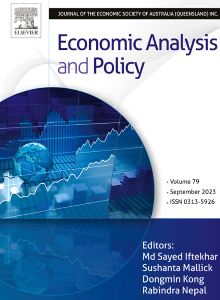全要素生产率与全球增长:塑造跨国收入不平等,1960-2019
IF 8.7
2区 经济学
Q1 ECONOMICS
引用次数: 0
摘要
本研究使用随机动态一般均衡模型考察了1960 - 2019年全球经济增长和跨国收入不平等。全要素生产率(tfp)主要推动全球产出增长,并形成收入差距。资本和劳动力市场的扭曲——以投资和劳动力楔子为代表——在具体情况下起着次要作用,特别是降低了中等收入国家的增长。全球增长的两大浪潮——战后工业化和全球化驱动的技术扩散——可以解释全要素生产率的优势。聚类分析证实了全要素生产率在增长奇迹和失败中的核心作用。1973年石油危机和2008年经济衰退等全球冲击减缓了增长,特别是在高收入国家,缩小了各国之间的收入差距。自2000年代以来,新兴经济体的全要素生产率提高减少了不平等。这些发现突出了以全要素生产率为中心的增长模式的理论和政策相关性,以及促进贸易开放、制度质量和创新的政策对提高全要素生产率、促进包容性增长和趋同的重要性。本文章由计算机程序翻译,如有差异,请以英文原文为准。
TFP and global growth: Shaping cross-country income inequality, 1960–2019
This study examines global economic growth and cross-country income inequality from 1960 to 2019 using a stochastic dynamic general equilibrium model. Total factor productivity (tfp), captured through the efficiency wedge, primarily drives global output growth and shapes income disparities. Distortions in capital and labour markets — represented by the investment and labour wedges — play secondary, context-specific roles, notably reducing growth in middle-income countries. Two major waves of global growth — post-war industrialization and globalizationdriven technological diffusion — can explain tfp predominance. Cluster analysis confirms the central role of tfp in both growth miracles and failures. Global shocks like the 1973 oil crisis and 2008 recession slowed growth, particularly in high-income countries, narrowing cross-country income disparities. Since the 2000s, tfp gains in emerging economies reduced inequality. These findings highlight the theoretical and policy relevance of tfp-centred growth models and the importance of policies promoting trade openness, institutional quality, and innovation to enhance tfp and foster inclusive growth and convergence.
求助全文
通过发布文献求助,成功后即可免费获取论文全文。
去求助
来源期刊

Economic Analysis and Policy
ECONOMICS-
CiteScore
9.80
自引率
9.20%
发文量
231
审稿时长
93 days
期刊介绍:
Economic Analysis and Policy (established 1970) publishes articles from all branches of economics with a particular focus on research, theoretical and applied, which has strong policy relevance. The journal also publishes survey articles and empirical replications on key policy issues. Authors are expected to highlight the main insights in a non-technical introduction and in the conclusion.
 求助内容:
求助内容: 应助结果提醒方式:
应助结果提醒方式:


